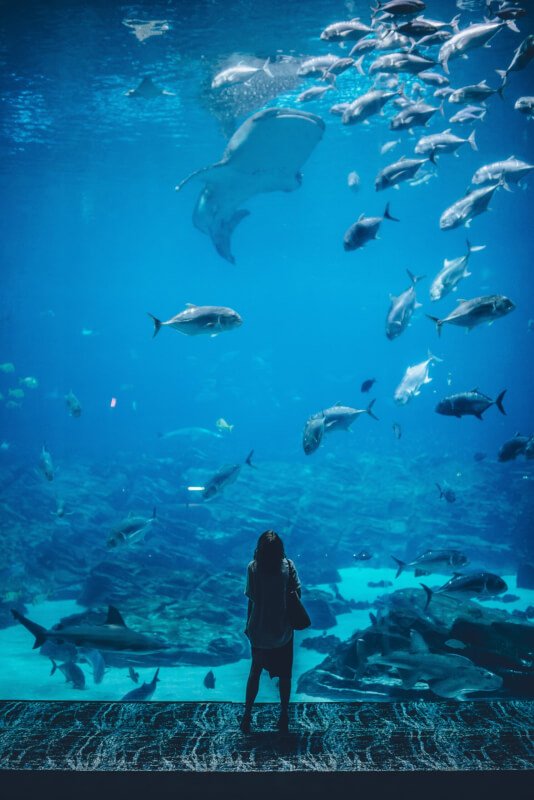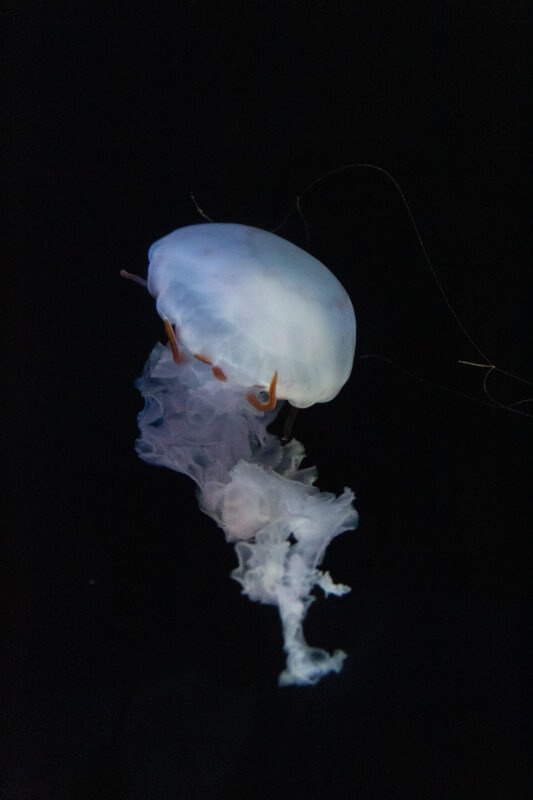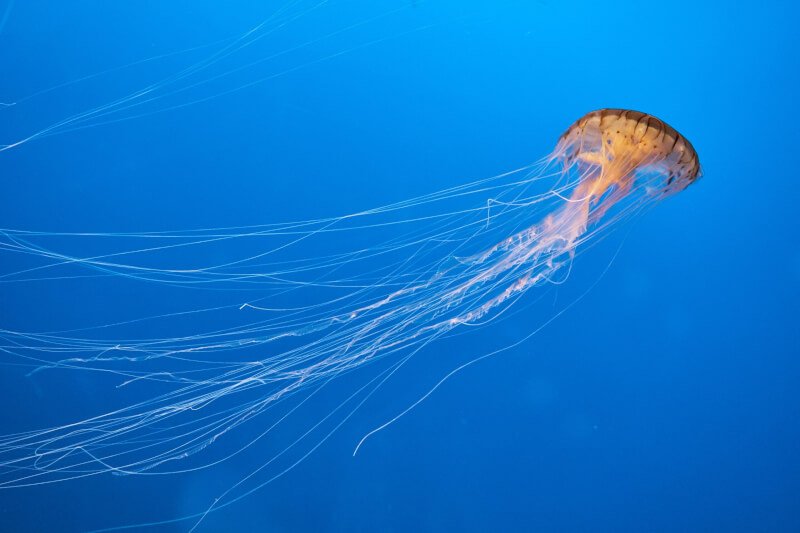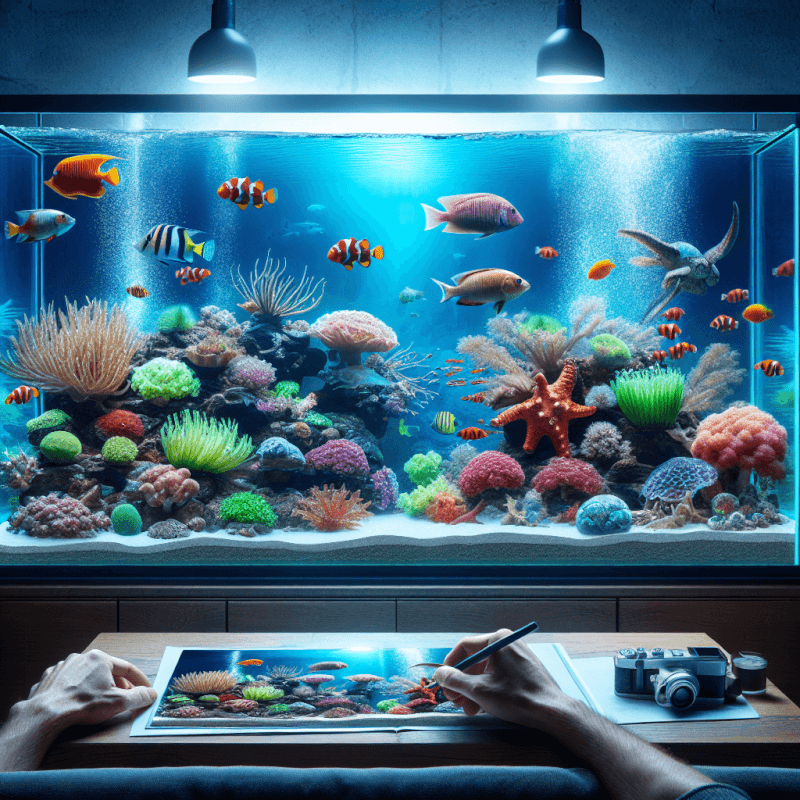So, you’ve decided to take the plunge and set up your very own saltwater aquarium. Congratulations! But where do you even begin? Don’t worry, we’ve got you covered. In this article, we’ll guide you through the step-by-step process of setting up your saltwater aquarium, from selecting the right tank to choosing the perfect fish. By the end, you’ll have all the knowledge and confidence you need to create a thriving underwater paradise right in your own home. So get ready to embark on this exciting aquatic adventure!
Choosing the Right Tank
Determining the Tank Size
When choosing a tank for your saltwater aquarium, it is important to consider the size that will best fit your needs and available space. The size of the tank will determine the number and types of fish and invertebrates you can house, as well as the overall stability of the tank’s ecosystem. Larger tanks generally provide a more stable environment and a greater variety of options for marine life. However, if you are a beginner or have limited space, a smaller tank may be a more practical choice.
Ready for Cat Trivia?
Test your knowledge about cats!

Selecting the Tank Material
There are various tank materials available for saltwater aquariums, including glass and acrylic. Glass tanks are sturdy, easy to clean, and generally less expensive than acrylic tanks. Acrylic tanks, on the other hand, are lighter, provide better insulation, and have a higher transparency level, which allows for better viewing. Acrylic tanks are also less prone to cracking and are easier to shape into unconventional shapes. Consider your budget, aesthetic preferences, and maintenance capabilities when choosing between glass and acrylic tanks.
Considering the Tank Shape
Tank shape is another important factor to consider when setting up a saltwater aquarium. There are rectangular, cube, bow-front, and cylindrical tanks, among others. Rectangular tanks are popular due to their versatility and efficient use of space. Cube tanks offer a unique aesthetic appeal and maximize the viewing area. Bow-front tanks provide a panoramic view and can be a focal point in any room. Cylindrical tanks offer an interesting design aspect and can be a great choice for marine life that prefers vertical swimming space. Carefully consider the needs of your marine life and the available space in your home when choosing the tank shape.
Setting Up the Equipment
Choosing a Proper Filtration System
A robust filtration system is crucial for maintaining a healthy saltwater aquarium. There are three types of filtration systems commonly used: mechanical, chemical, and biological. Mechanical filtration removes debris and particulate matter from the water, chemical filtration removes dissolved impurities, and biological filtration converts harmful ammonia and nitrite into less harmful nitrate. Consider using a combination of these filtration methods to effectively remove waste and maintain water quality in your tank.
Selecting the Right Lighting
Lighting is not only essential for the aesthetic appeal of your saltwater aquarium but also for the health and growth of your marine life. Different types of marine life have varying lighting needs, so it is important to research the specific requirements of the species you plan to keep. LED lights are a popular choice for saltwater aquariums due to their energy efficiency, adjustable intensity, and various color options. T5 fluorescent lights are also commonly used because they provide excellent color rendition and promote the growth of photosynthetic organisms. Take into account the type of marine life you want to keep and the desired aesthetic when selecting the right lighting for your tank.
Installing a Heater
Maintaining a stable water temperature is crucial for the well-being of your marine life. Most saltwater aquariums require a heater to ensure the water temperature stays within the appropriate range. Consider using a submersible heater with a built-in thermostat to maintain a consistent temperature. It is important to choose the right size heater for your tank, based on the volume of water and the temperature requirements of the marine life you plan to keep.
Using a Protein Skimmer
A protein skimmer is an essential piece of equipment for saltwater aquariums, as it helps remove organic compounds from the water by creating fine bubbles that attract and remove waste. This process helps maintain water clarity and reduce the risk of harmful chemical imbalances. Choose a protein skimmer that is appropriate for the size of your tank and consider models that offer adjustable settings for optimal performance.
Adding Powerheads for Water Circulation
Water circulation is vital in a saltwater aquarium as it helps distribute oxygen, remove debris, and prevent stagnant areas. Powerheads create water movement by propelling water in a specific direction or creating a wave-like motion. By strategically placing powerheads in your tank, you can mimic the natural flow of the ocean and ensure a healthy environment for your marine life. Consider the size of your tank and the flow requirements of your marine life when selecting and positioning powerheads.

Preparing the Water
Understanding the Water Parameters
Before setting up your saltwater aquarium, it is crucial to understand and monitor the water parameters to create a suitable environment for your marine life. Parameters such as temperature, pH, salinity, ammonia, nitrite, and nitrate levels should be regularly tested and maintained within the appropriate range. Use a reputable water testing kit to monitor these parameters and make any necessary adjustments to ensure the well-being of your marine life.
Choosing the Right Salt Mix
Salt mixes are used to create artificial seawater for your saltwater aquarium. It is important to choose a high-quality salt mix that provides essential elements and trace elements necessary for the health and growth of your marine life. Consider consulting with experienced aquarists or seeking recommendations from reputable aquarium stores to select a salt mix that suits your specific needs.
Mixing Saltwater Properly
Mixing saltwater properly is essential to maintaining stable water parameters in your saltwater aquarium. Follow the instructions provided by the salt mix manufacturer to ensure accurate salinity levels. Use a clean container and a reliable source of freshwater to avoid any potential contamination. It is recommended to mix saltwater in a separate container before adding it to the tank, allowing for proper mixing, temperature adjustment, and testing.
Testing the Salinity Level
Salinity, or the concentration of salt in the water, is a critical parameter to monitor in a saltwater aquarium. Use a reliable refractometer or hydrometer to measure the salinity level and ensure it falls within the appropriate range for your marine life. Regularly test and adjust the salinity level, especially after water changes, to provide the optimal living conditions for your marine life.
Adding Live Rock and Substrate
Choosing the Right Live Rock
Live rock serves as a natural biological filter and provides a habitat for beneficial bacteria, invertebrates, and other marine life in your saltwater aquarium. When selecting live rock, consider its appearance, condition, and compatibility with the marine life you plan to keep. Look for rocks that are well-cured, free of pests, and visually appealing.
Cleaning and Curing Live Rock
Before adding live rock to your saltwater aquarium, it is important to properly clean and cure it to remove any unwanted organisms or debris. Scrub the rock with a brush to remove any loose material and then soak it in freshwater or saltwater to remove any excess debris. Curing live rock involves allowing it to go through a natural process of biological filtration, which establishes a beneficial bacterial population on the rock’s surface. This process can take several weeks but is essential to prevent any negative impact on your tank’s water quality.
Determining the Ideal Substrate Type
The substrate in your saltwater aquarium not only provides a natural look but also serves as a home for beneficial bacteria and various marine life. There are different types of substrates available, such as crushed coral, aragonite sand, and live sand. Consider the specific needs of your marine life and the desired aesthetic when choosing the ideal substrate type for your tank.
Adding Substrate to the Tank
Once you have selected the appropriate substrate, carefully add it to your saltwater aquarium. Make sure to rinse the substrate thoroughly to remove any fine particles or debris before placing it in the tank. Create a uniform layer of substrate, ensuring that it is deep enough to support the growth of beneficial bacteria and provide a suitable environment for marine life. Be mindful of any caves or hiding spots you may want to create using the substrate.

Introducing Marine Life
Cycling the Tank
Cycling your saltwater aquarium is an important process that establishes the necessary beneficial bacteria to maintain a healthy and balanced ecosystem. This process involves creating an ammonia source, often through the addition of fish food or pure ammonia, which feeds the bacteria and allows them to convert harmful ammonia into nitrites and then into nitrates. Cycling typically takes several weeks, during which you will need to regularly test the water parameters and make any necessary adjustments. Once the cycling process is complete, the water parameters should stabilize, indicating that it is safe to introduce marine life into the tank.
Choosing the Right Fish
When selecting fish for your saltwater aquarium, it is important to consider their compatibility with one another and the tank’s overall ecosystem. Research the specific needs, behaviors, and sizes of the fish you are interested in keeping to ensure they will thrive in your tank. Consider factors such as feeding habits, swimming levels, and territoriality when determining the compatibility of different fish species. It is also essential to choose fish that are properly acclimated to aquarium life and are in good health.
Considering Invertebrates and Corals
In addition to fish, many saltwater aquarium enthusiasts also enjoy keeping invertebrates and corals. Invertebrates, such as shrimp, crabs, and snails, contribute to the diversity and balance of the tank’s ecosystem. Corals add vibrant colors and intricate structures, creating a stunning visual display. When considering invertebrates and corals, research their specific care requirements, as they may have unique lighting, feeding, and water flow needs.
Quarantining New Additions
To minimize the risk of introducing diseases or parasites into your saltwater aquarium, it is recommended to quarantine any new additions before introducing them to the main tank. A separate quarantine tank allows you to closely monitor the health of the new fish or invertebrates and treat any potential issues without affecting the established ecosystem of the main tank.
Acclimating the Marine Life
Proper acclimation is essential when introducing new marine life to your saltwater aquarium. The acclimation process helps the marine life adjust to the new water chemistry and temperature. Slowly transition the fish or invertebrates from their transport bag to the main tank by gradually adding small amounts of water from the tank to the bag. This process should be done over a period of time to allow the marine life to acclimate slowly and minimize stress.
Maintaining the Saltwater Aquarium
Monitoring Water Parameters Regularly
Regular monitoring of water parameters is crucial for the long-term success of your saltwater aquarium. Use a reliable water testing kit to monitor parameters such as temperature, pH, salinity, ammonia, nitrite, and nitrate levels. Make any necessary adjustments to maintain optimal water quality and address any issues promptly to prevent more significant problems.
Maintaining Proper Lighting Schedule
Proper lighting plays a crucial role in the health and growth of the marine life in your saltwater aquarium. Establish a regular lighting schedule that mimics the natural day-night cycle to provide consistency and stability for your marine life. Adjust the intensity and color spectrum of the lights to accommodate the specific needs of different marine life, such as corals that require higher light levels for photosynthesis.
Performing Regular Water Changes
Regular water changes are essential in maintaining the overall health and stability of your saltwater aquarium. By removing a portion of the old water and replacing it with fresh saltwater, you can dilute accumulated impurities and replenish essential elements. Aim to perform a water change of approximately 10-20% every two to four weeks, depending on the specific needs of your tank and the water parameters.
Cleaning the Tank and Equipment
Regular cleaning of the tank and equipment is necessary to maintain a clean and healthy environment for your marine life. Use a turkey baster or a siphon to remove any debris or excess waste from the substrate. Clean the glass or acrylic walls of the tank using an algae scraper or magnet cleaner. Additionally, check and clean the filtration system, protein skimmer, and powerheads regularly to ensure optimal performance.
Feeding the Marine Life Correctly
Proper feeding is crucial to the well-being of your marine life. Research the specific dietary needs of the fish, invertebrates, and corals in your saltwater aquarium. Feed a varied diet that includes high-quality commercial foods, as well as fresh or frozen foods. Be mindful not to overfeed, as excess food can lead to poor water quality and other health issues. Monitor feeding habits and adjust the amount and frequency of feeding as needed.

Dealing with Common Challenges
Preventing and Treating High Nitrates
High nitrate levels can be detrimental to the health of your saltwater aquarium. Ensure proper filtration and perform regular water changes to prevent nitrates from accumulating. If nitrate levels become elevated, consider using nitrate-specific resins or adding nitrate-consuming organisms such as macroalgae or certain types of live plants. Monitor nitrate levels regularly and take appropriate action to maintain a healthy balance.
Managing Algae Growth
Algae growth is a common challenge in saltwater aquariums. Controlling lighting duration and intensity, maintaining proper water flow, and implementing a nutrient control strategy can help prevent excessive algae growth. Regular cleaning of the tank and equipment, such as removing algae from the glass walls, will also reduce the buildup of unsightly algae. Consider incorporating herbivorous fish or invertebrates, such as certain species of tangs or hermit crabs, to naturally control algae growth.
Dealing with Ammonia Spikes
Ammonia spikes can occur due to various reasons, such as overfeeding, dead or decaying organisms, or inadequate biological filtration. Regularly test water parameters to detect any ammonia spikes early on. If ammonia levels become elevated, take immediate action by reducing feeding, increasing water flow, and adding beneficial bacteria or chemical treatments to detoxify ammonia. Address the root causes of ammonia spikes to prevent them from recurring.
Avoiding Fish Diseases
Fish diseases can be introduced to your saltwater aquarium through new additions or poor water quality. Quarantining new fish, practicing proper acclimation techniques, and maintaining optimal water quality can help prevent the introduction and spread of diseases. Observe your marine life closely for any signs of illness, such as abnormal behavior, loss of appetite, or physical abnormalities. Treat any diseases promptly and seek advice from a knowledgeable professional or aquarium community if needed.
Controlling Temperature Fluctuations
Temperature fluctuations can stress and potentially harm your marine life. Ensure that your tank’s heater is reliable and properly sized to maintain a consistent water temperature. Place the heater near a powerhead or use a circulation pump to disperse the heated water evenly throughout the tank. Regularly monitor the water temperature and make any necessary adjustments to prevent rapid temperature changes.
Additional Tips and Considerations
Ensure a Proper Quarantine Tank Setup
Setting up a separate quarantine tank is highly recommended for any saltwater aquarium enthusiast. A quarantine tank provides a controlled environment where you can observe and treat new additions before introducing them to the main tank. Equip the quarantine tank with a filtration system, heater, and lighting appropriate for the specific needs of the marine life you plan to quarantine. Regularly test and maintain the water parameters in the quarantine tank, and avoid using equipment or decorations that have been in the main tank to prevent cross-contamination.
Choose Compatible Marine Life
When introducing new fish, invertebrates, or corals to your saltwater aquarium, it is essential to consider their compatibility with existing tank inhabitants. Some species may be territorial, aggressive, or have specific dietary requirements that may conflict with others. Research and carefully select marine life that will coexist harmoniously and promote a healthy and balanced ecosystem.
Research Before Purchasing
Before purchasing any marine life for your saltwater aquarium, thoroughly research the specific requirements, behavior, and compatibility of the species you are interested in keeping. Consider factors such as water temperature, pH levels, dietary needs, and potential tank size requirements. By conducting thorough research, you will be better equipped to provide the optimal care and environment for the marine life in your tank.
Consider the Cost and Long-Term Commitment
Saltwater aquariums can be a significant financial investment and require ongoing maintenance and care. Consider the cost of equipment, live rock, substrate, marine life, and ongoing expenses such as water testing kits, food, and electricity. Additionally, recognize the long-term commitment required to maintain a thriving saltwater aquarium. Assess your budget, time availability, and dedication before embarking on the journey of setting up a saltwater aquarium.
Join an Aquarium Community for Support
Joining an aquarium community or forum can provide valuable support, information, and guidance throughout your saltwater aquarium journey. Engage with experienced aquarists, share experiences, and seek advice to supplement your knowledge and ensure the success of your saltwater aquarium. Aquarium communities can also be a great source of inspiration and a place to share the beauty and joy of your thriving marine ecosystem.
Setting up a saltwater aquarium can be a rewarding and exciting experience. By following these comprehensive guidelines and considering the various aspects outlined, you will be well on your way to creating a thriving saltwater ecosystem that will provide enjoyment and wonder for years to come. Remember to approach the process with patience and care, and always prioritize the well-being of your marine life.



